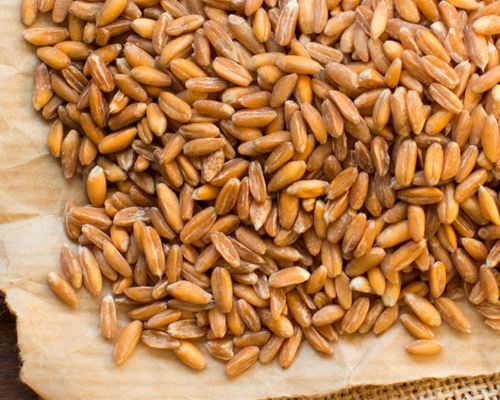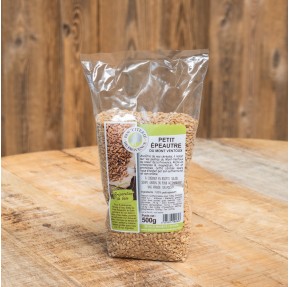- Tags: spelt
Spelt : Its Benefits and Recipe Ideas
Discover the numerous benefits of spelt as well as tasty recipe ideas to incorporate it into your diet. This ancient grain is packed with essential nutrients and offers a multitude of culinary options to enrich your daily life.
The Benefits of Spelt's Nutrients
Spelt (Triticum monococcum) is an ancient variety of wheat that is rich in essential nutrients beneficial for health. This grain is an excellent source of dietary fiber, which promotes healthy digestion by improving intestinal transit and helping to prevent gastrointestinal disorders. Additionally, spelt is rich in high-quality proteins, providing the essential amino acids necessary for the building and repair of body tissues.
Regarding micronutrients, spelt is an important source of various minerals such as iron, magnesium, and zinc, which play vital roles in many biological functions: red blood cell formation, regulation of blood pressure, and strengthening the immune system.
Moreover, it is also rich in B vitamins, including thiamine (B1) and niacin (B3), which are essential for energy production from food and optimal functioning of the nervous system.
Spelt is naturally low in saturated fats and sodium, making it an ideal dietary choice for those looking to maintain a balanced diet and reduce the risk of cardiovascular diseases. Its high fiber and protein content also contribute to a feeling of fullness, which can help control appetite and promote weight management.
Incorporating Spelt into Your Daily Diet - Recipe Ideas
Adding spelt to your daily diet is a delicious way to improve your health and diversify your meals.
Here are some simple ideas to incorporate this valuable ingredient into your culinary routine:
Spelt Salad: the star of Provencal starters
Prepare a fresh and colorful salad by mixing cooked spelt with crisp vegetables such as tomatoes, cucumbers, and bell peppers. Add fresh herbs like parsley or coriander, as well as olives and feta cheese for a Mediterranean touch.
Voilà! You have a delicious salad!
Spelt Risotto: the trendy recipe that never fails
Use cooked spelt as a base for a creamy and comforting risotto. Add sautéed mushrooms, fresh spinach, and grated parmesan for a tasty vegetarian version.
A simple and deliciously savory dish.
Spelt Soup: guaranteed comfort
Prepare a comforting soup by cooking spelt with vegetables like carrots, celery, and leeks in aromatic vegetable broth. Season with fresh herbs such as thyme and rosemary for maximum flavor.
Practical Tips for Consuming Spelt
Here are some practical tips to easily incorporate spelt into your daily diet:
Tip #1: Wash spelt grains before cooking to remove any dust or impurities.
Tip #2: Spelt takes 10 minutes to cook; 1 cup of spelt = 2 cups of water for cooking.
Tip #3: Incorporate spices or broth during cooking to add flavor.
Tip #4: Add cooked spelt to your salads, soups, stews, or stir-fries to increase their nutritional value and texture.
Tip #5: This cereal can be used in various forms: flakes, flour, grains, pasta, cakes, biscuits, etc. Feel free to incorporate all these variations into your dishes to diversify your diet and fully enjoy its nutritional benefits.
Deciphering the Difference between Spelt and Einkorn
Spelt and einkorn are two varieties of ancient wheat used in cooking, which have small differences:
Different botanical species: spelt (Triticum aestivum) is a variety of soft wheat, while einkorn (Triticum monococcum) is a variety of durum wheat. In terms of size, einkorn grains are generally smaller than those of spelt, which can influence their texture and cooking time.
Different nutritional composition: both varieties have a similar range of nutrients, but einkorn is often considered to have a lower gluten content than spelt. This characteristic sometimes makes einkorn better tolerated by people sensitive to gluten, although it may not necessarily be suitable for those following a strictly gluten-free diet.
Culinary use: spelt and einkorn can be substituted for each other in many recipes, but due to their slightly different size and texture, they may require adjusted cooking times.
You are now better informed about spelt. We hope you will consider incorporating it into your dishes soon!

Small spelt grain
_1.jpg)
Spelt in salad
.jpg)
Spelt
_1.jpg)
Cooked small spelt
.jpg)
.jpg)
.jpg)

VISITING THE FACTORY
Dive into the history of the Biscuit Factory, have fun with several playful activities adapted for the little ones, take a look at our various workshops (chocolate, calissons, biscuits...), discover how we work with passion and love for our beautiful region... Come and spend a pleasant family time, ending with a nice tasting in our gourmet hall of 300m2! You will find our 150 recipes, our fresh pastries and more than 350 locally sourced products carefully selected from producers near the Factory, and perhaps end with a little gourmet break in our tea room area.








